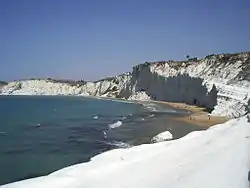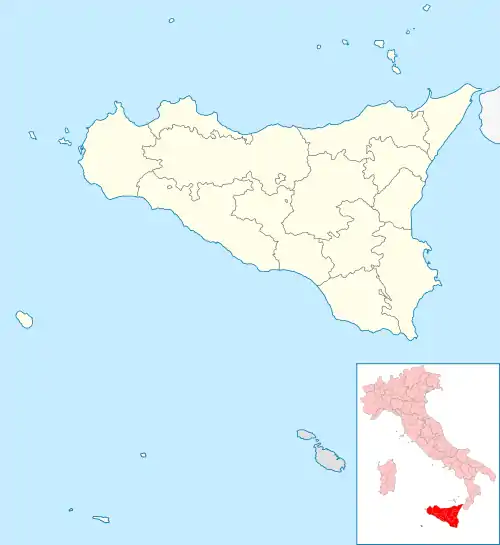Realmonte | |
|---|---|
 The so-called Scala dei Turchi. | |
Location of | |
 Location of in Italy  Realmonte (Sicily) | |
| Coordinates: 37°19′N 13°28′E / 37.317°N 13.467°E | |
| Country | Italy |
| Region | Sicily |
| Province | Agrigento (AG) |
| Area | |
| • Total | 20.37 km2 (7.86 sq mi) |
| Elevation | 144 m (472 ft) |
| Population (2018-01-01)[2] | |
| • Total | 4,540 |
| • Density | 220/km2 (580/sq mi) |
| Time zone | UTC+1 (CET) |
| • Summer (DST) | UTC+2 (CEST) |
| Website | Official website |
Realmonte (Sicilian: Muntiriali) is a comune (municipality) in the Region of Agrigento in the Italian Provence Sicily, located about 90 kilometres (56 mi) south of Palermo and about 10 kilometres (6 mi) west of Agrigento.
Realmonte borders the following municipalities: Agrigento, Porto Empedocle, Siculiana.
A tourist attraction in the town is the Scala dei Turchi.
The ancient Roman villa nearby with exquisite mosaics can be visited.
History

The large and elaborate Roman villa of Realmonte (also called Durrueli) is located on the coast. In Roman times this would have represented the seat of a large estate or latifundia. Excavations have recently revealed more of the extent and history of the site.[3][4]
It is not known when the municipality was founded, but its origins probably go back to the second half of the 17th century.
The Roman villa
The Roman villa was first discovered in 1907 consisting of two rooms with elaborate opus sectile in expensive coloured marbles and three rooms with mosaic floors dating from the 1st c. AD.
Further excavations in 1979-1985 brought to light and adjacent wing of the villa with the thermal baths, probably built in a later period in 2nd c. AD. The villa included a peristyle around a garden which included the impluvium, a large basin for collecting rainwater.[5]
Excavations resumed in 2017 and revealed that the villa extended to an area of 5000 m2 and was occupied until the 7th c. AD. It became a major industrial site producing tiles and pottery in the later period.[6]
Twin towns
References
- ↑ "Superficie di Comuni Province e Regioni italiane al 9 ottobre 2011". Italian National Institute of Statistics. Retrieved 16 March 2019.
- ↑ "Popolazione Residente al 1° Gennaio 2018". Italian National Institute of Statistics. Retrieved 16 March 2019.
- ↑ Archeologists uncover new economic history of ancient Rome: https://phys.org/news/2017-08-archeologists-uncover-economic-history-ancient.html
- ↑ LA VILLA ROMANA MERAVIGLIE ARCHEOLOGICHE E PANORAMA DA SOGNO: http://livingagrigento.it/Cultura/main/cultura?strutt_id=1277__Sito-Archeologico-Villa-Romana-Durrueli
- ↑ The Roman Villa in the Mediterranean Basin: Late Republic to Late Antiquity, Annalisa Marzano, Guy P. R. Métraux, Cambridge University Press, 30 Apr 2018, p 200
- ↑ "Archeologists uncover new economic history of ancient Rome".